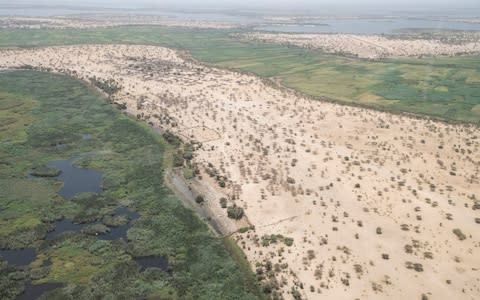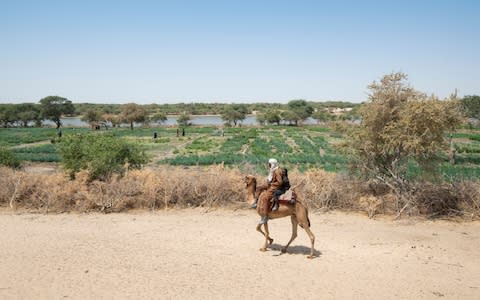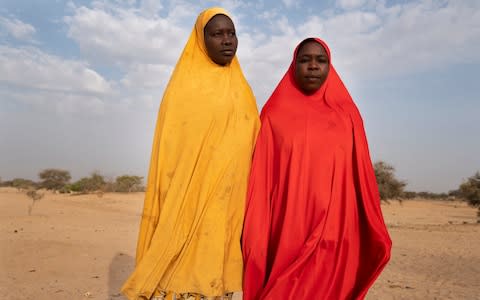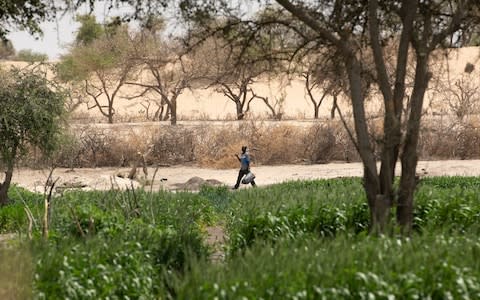Africa's Great Green Wall: Can an ambitious project bring life back to the desert?

Water is life in the Lake Chad basin. For centuries the lake was the largest reservoir in the Sahel – the semi-arid belt spanning Africa south of the Sahara Desert – relied upon by 30 million people.
Naturally shallow and replenished by monsoon rains, the Chari River from the south and the Yobe from the north-west, the lake – which once covered eight per cent of the continent – has always ebbed and flowed. But in recent decades these seasonal variations have stalled.
Modern satellite images show an isolated blue dot in the middle of an arid desert. Lake Chad is vanishing.
Adam Abdullah lives on the edge of this dot. He is 75, a rarity in Chad, the country with the world’s lowest life expectancy (53 for men and 54 for women), and has made a home for himself in a conical shelter built from dried rushes above an evaporated part of the lake.
He moved to his present accommodation on the outskirts of a village called Melea four years ago, after Boko Haram militants launched a night-time assault on his ancestral home. ‘Many people died and many houses were destroyed,’ he says.

A decade ago his cattle died in a famine. Now he is waiting here, hoping for a sliver of land on which to plant crops. Gesturing out over the dried lakebed where swallows dip and dive in pursuit of hatching insects, he tells me: ‘There used to be water all around here, but I have watched it disappear.’
Lake Chad, which spanned 9,652 square miles in 1963, has shrunk by an estimated 90 per cent in recent decades. Climate change is to blame in particular, say experts, with population growth and unplanned irrigation also contributing to what the United Nations Environment Programme calls an ‘ecological disaster’ – one fuelled by the Islamist terrorist group Boko Haram, which 10 years ago sprang up in the Lake Chad basin.
The ongoing conflict has claimed tens of thousands of lives and displaced an estimated 2.5 million people in the region. Families who for generations depended on the lake to sustain them now languish in front of a horizon of sand.
On the other side of Melea, women in brightly patterned cloth and men in long loose-fitting robes gather about the community well. During periods of drought they come here to pray for rain.
Today, in holes dug into the sand and lined with goat poo, they are planting seeds of acacia, desert date, guava, citron and mango trees.
‘In five years the sand has come so quickly towards our crops,’ explains Mbodou Mahamat, who is president of the village’s agriculture scheme. ‘Our community has been here for 400 years and now we are watching the lake go down. I’m afraid if there is no water then we will die. We hope these trees will protect us.’
This plantation of a few thousand trees is part of something that it is hoped will grow to become a new wonder of the world: a Great Green Wall spanning almost 5,000 miles from coast to coast, across more than 20 countries.

By 2030 the ambition of the project is to restore 250 million acres of degraded land and bring security to one of the most impoverished regions on earth; stemming conflict and stopping the mass migration to Europe witnessed in recent years.
Around Lake Chad it is hoped the wall can bring stability: both in the most literal sense, by holding back the desert, and by providing opportunity for those who have watched their main life source disappear before their eyes.
Already $8 billion has been pledged to build the Great Green Wall. Among its high-profile backers is Fernando Meirelles (director of City of God and The Constant Gardener), who is the executive producer of a soon-to-be-released documentary following the route of the Great Green Wall, which is being screened at film festivals this summer.
The Brazilian, who helped create the opening ceremony of the Rio Olympics in 2016, has great faith in the power of trees. Every year he plants up to 15,000 on land he owns in Brazil. During the Olympic ceremony he gave every athlete a seed to plant and illuminated the stage with images of the Great Green Wall.
He describes the project as a ‘game-changer’ for Africa, albeit one rife with difficulty. ‘There are many political problems in each country and each territory has different issues,’ he says. ‘But I think it can be done. It can really keep people living in these places, and if we don’t act the migration problem in a few years will be unbearable. Especially for Europe. It’s the kind of project that should be supported by the whole planet.’
Temperatures have risen by 1C in the Sahel since 1970, nearly double the global average over the same period. The region is regarded as the most disproportionately affected by global warming on earth.

In Chad, for example, temperatures now exceed 50C in the dry season, shrivelling crops where they grow. Across the Sahel, 80 per cent of land is deemed degraded, cutting off the few opportunities that previously existed for the world’s youngest population, which is expected to reach 100 million by 2020 – 65 per cent of whom will be under 25.
Such dire economic prospects create fertile recruitment ground for terrorists. Around Lake Chad, Boko Haram offers up anything from new trainers and phones to access to doctors and schools.
‘These terrorist groups are vicious,’ says Ibrahim Thiaw, executive secretary of the UN Convention to Combat Desertification (UNCCD), which oversees the Great Green Wall. ‘They exploit society’s weaknesses. They attract people who are not just disillusioned but desperate.’
Many who have suffered at the hands of Boko Haram languish in the Dar es Salaam refugee camp (meaning ‘place of peace’), a tent city in the desert past the town of Baga Sola in Chad.
More than 6,000 Nigerian refugees have poured into the camp this year from over the border after Boko Haram militants raided three villages on the Nigeria side of Lake Chad on December 26, 2018. The new arrivals have added to the 5,000 Nigerian refugees who had already moved here since the camp was established in 2014.

Early each morning, before the wind blowing over the Sahara has whipped the camp up into a dusty squall, Kaka Hajja Abatcha takes a 30-minute walk with a friend living in a nearby tent. They stroll hand-in-hand past heaps of plastic rubbish and the stumps of acacia trees hacked down for firewood.
Kaka Hajja, who is 30 and dressed in a red jilbab (a full-length garment), says they always walk in silence. She has lived in the camp for one month and six days, she says, counting the dates on fingers decorated with henna tattoos.
She fled Nigeria after Boko Haram militants raided her village; rounding up anybody deemed to be a businessman or a civil servant. Her father, a rice salesman, was among the 100 or so executed – his body dumped by the side of the road.
Kaka Hajja escaped with her five children, aged three to 12, carrying three blankets, their mosquito nets and the woven mat we are sitting on. She became separated from her husband and hasn’t seen him since, although she hopes he will be able to join them soon.
‘I cook breakfast and then after that I just sit here,’ she says. ‘There is nothing to do – it is very difficult, but most of all I am worried about my children.’
Their one meal of ground-up maize a day is not uncommon in the camp. The UN World Food Programme (WFP), which distributes food rations in the Dar es Salaam camp, does not have enough funding to provide full rations to those living here.

Nancy Walters, the WFP country director in Chad, says there is now widespread acceptance that simply pouring continued resources into refugee camps will not stem the number of people fleeing conflict and climate change. Instead, she points to a recent shift towards building resilience projects outside of camps.
In a number of initiatives part-inspired by the Great Green Wall, the WFP is helping villages dig boreholes, plant crops and undertake large-scale tree-planting projects around Lake Chad. Villages that have grown used to defending themselves from raids with machetes and clubs are now preparing arboreal battlements.
‘It’s about trying to stop that environmental degradation in its tracks and reverse what’s happened at this point,’ Walters says. ‘Things are just getting worse. The impact we are seeing in Europe and North America with migration is also making people stop and think. The majority of people who migrate don’t necessarily want to, so what can we do to make them stay?’
The roots of the Great Green Wall snake back to the 1970s, when the Sahel was rocked by successive droughts, prompting political leaders across the continent to discuss ways of protecting their populations from climate change. The Marxist revolutionary leader of Burkina Faso, Thomas Sankara, was one of the leading early advocates of the wall.
‘You cannot carry out fundamental change without a certain degree of madness,’ he said in 1985, two years prior to his assassination. ‘The courage to invent the future.’ The wall remains an African-led initiative, with each country involved in coordinating its own planting projects.

The first seeds were sown in 2008, drought-resistant acacia planted in the Senegalese village of Widou Thiengoly, overseen by the country’s technical director of the Great Green Wall, Colonel Papp Sarr (the rank denotes years of civil service in various environmental departments rather than the military).
Over the ensuing decade, Colonel Sarr says, the country has planted 20 million trees, encompassing 110,000 acres and stretching nearly 340 miles. While the original idea was for the wall to be an unbroken entity, its modern incarnation is a mosaic of plantations each creating its own microclimate.
Already, he says, it is having an important effect restoring degraded land, creating industry where there was none, and keeping children in school where previously they would have been sent to drive livestock ever further from home in pursuit of diminishing feed.
The village of Koyli Alpha in northern Senegal is one of these desert redoubts. What strikes you is the birdsong; flocks of Sahel bush sparrow, weaver birds and cut-throat finches dart between the trees. Twelve acres of the Great Green Wall were planted here in 2013, alongside a community vegetable garden now used by 250 people.
As with other Great Green Wall projects, money was paid to villagers to plant the trees, and they were provided with a water source to maintain the garden – in this case a borehole regulated to release only 200 litres a month to irrigate the crops. (Boreholes provide limited temporary solutions – they involve drilling down into the desert to tap into the water table and extract water from the earth. However, the water is pumped out using a diesel engine, so they are expensive to run. Also, with no rain coming in, they need to be regulated strictly so they don’t completely dry out the water table before it has time to replenish.)

Villagers say the project has had a transformative effect. ‘We grow vegetables to feed our families and to sell for money,’ says Jamilatou Ka, a 30-year-old mother of four children. ‘We’ve even opened a bank account that people can borrow money from. It makes money, takes me out of the house and gives me freedom.’
Fifteen-year-olds Kadiatou Diallo, Aissata Diallo and Fatimata Ba say working in the garden kept them in school. ‘Of course this gives us more options,’ says Fatimata. ‘Once we have finished our studies we don’t want to go anywhere else. We want to stay in the village and practise all of our knowledge here.’
A few miles away is another plot of the wall where 10,000 trees were planted five years ago, surrounded by a fence in order to prevent them from being munched by marauding herds of cattle and goats, which have reduced much of this part of the Sahel to desert scrub.
Here, livestock are only permitted to enter during a few months of the year, and the difference in habitat is startling. Monkeys, jackals, kudu (antelopes) and rabbits have all returned.
Surrounding villagers are also starting to make money out of the trees, harvesting the acacia for gum arabic as well as being able to better feed their animals in a more sustainable way.

Seventy-one-year-old cattle breeder Moussa Sy, whose family farm is next to the site, was instrumental in persuading his fellow herders to allow planting here. ‘The future of the Great Green Wall is more important than the present,’ he says, cradling his three-year-old granddaughter Faty in his arms.
Since 2010 an estimated 1.5 million people have left sub-Saharan Africa for Europe and the US, according to a study released last year by the Pew Research Center. Pew also surveyed respondents in six countries about plans to migrate.
Senegal ranked highest, with 44 per cent of those asked saying they planned to move to another country within five years. So many here have embarked on the often-perilous journey that there is a phrase for it: ‘Get to Europe or die trying.’
Ibra Ndaw, 32, was one of the young men to go in search of a new life. A struggling taxi driver in the city of Touba, in 2016 he decided to leave his wife of seven years, Fali Ndiaye, and two young children to travel to Europe and raise money for his family.

Holding their wedding photograph in shaking hands, Fali Ndiaye describes how she received a phone call from one of his travelling companions, who said the boat to Italy her husband had been on had capsized in the ocean, and most of those on board – including Ibra – had drowned.
‘I will never forget the day of that phone call,’ she says. ‘I feel so lonely without him.’
Often they leave with no word of warning. Bamba Samb, a 29-year-old tailor from Dahra, a town an hour or so north of Touba, vanished in 2016 without telling his family. He too drowned in the Mediterranean en route to Italy. Like thousands of others his body has never been recovered.
‘I think about him every day,’ says his father, Abdou. ‘Every parent is worried their son will be next but what can we do? Climate change has really affected people here. That is why all our young people try and find jobs somewhere else.’
Will a tree ever stand in their way? Colonel Sarr is insistent that in time the Great Green Wall can do more than any barrier to dissuade his countrymen from fleeing.
‘There is a philosophy that says first there were trees, then there was man and then there was the desert,’ he says. ‘It depends on us now. But a tree can be a powerful thing.’
Protect yourself and your family by learning more about Global Health Security

 Yahoo News
Yahoo News 
